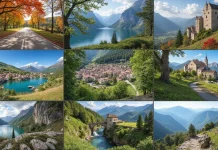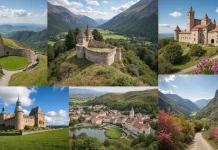Exploring Europe’s Ancient Ruins and Archaeological Sites
The Allure of Europe's Ancient History
Europe's landscape is a rich tapestry of history woven across its sprawling fields, towering mountains, and winding rivers. The echoes of ancient civilizations are etched into every corner, each ruin and site telling stories of epochs long past. From the dramatic ruins of the Roman Empire to the enigmatic Stonehenge, Europe’s archaeological treasures offer a fascinating glimpse into the continent’s vibrant and varied past.
The Roots of Western Civilization in Greece
The Magnificence of the Acropolis
Perched high above the city of Athens, the Acropolis stands as a testament to ancient Greek civilization and its lasting influence on the world. The Parthenon, its iconic temple dedicated to the goddess Athena, is a masterpiece of classical architecture. As you wander through the ruins, it’s easy to imagine the once-bustling center of philosophy and democracy that helped shape modern thought.
The Mystery of Delphi
Nestled on the slopes of Mount Parnassus, Delphi was once considered the center of the world by the ancient Greeks. The site was home to the Oracle of Delphi, a powerful priestess who delivered cryptic prophecies. Exploring the ruins of the Temple of Apollo and the ancient theatre, visitors can immerse themselves in the mysteries and myths that surrounded this once-sacred site.
Italy: The Heart of the Roman Empire
The Colosseum's Triumph and Tragedy
Standing as a symbol of the Roman Empire's strength and ingenuity, the Colosseum in Rome is an awe-inspiring monument to ancient engineering. This massive amphitheater was the scene of spectacular gladiatorial contests and public spectacles. Walking through its ancient corridors, you can almost hear the roar of the crowd and the clang of swords, bringing the past to life in vivid detail.
Pompeii: A City Frozen in Time
The eruption of Mount Vesuvius in AD 79 buried the city of Pompeii under layers of ash, preserving it remarkably well. Today, it offers a unique window into everyday Roman life. Wandering through its well-preserved streets, you can explore homes, eateries, and forums, each freeze-framed in a moment of history. Pompeii provides a haunting yet intimate glimpse into the routines and realities of ancient Roman society.
The Mystique of Britain's Prehistoric Monuments
Unraveling the Enigma of Stonehenge
Stonehenge, with its colossal standing stones, continues to capture the imaginations of historians and visitors alike. This prehistoric monument raises many questions: how was it constructed, and for what purpose? As you stand among the ancient stones, their arrangement against the changing sky evokes a sense of wonder, offering more questions than answers and inviting endless exploration and speculation.
Avebury's Expansive Stone Circle
Less famous than Stonehenge but equally captivating, Avebury boasts the largest stone circle in Europe. Unlike Stonehenge, you are free to wander among the stones, touching and contemplating these ancient markers. The nearby prehistoric sites, including Silbury Hill and West Kennet Long Barrow, complete a fascinating exploration of Britain's ancient past.
France's Hidden Gallic and Roman Treasures
The Roman Theatre of Orange
Located in the picturesque Provence region, the Roman Theatre of Orange stands as one of the best-preserved Roman theatres in Europe. Its massive stage wall and tiered seating remain largely intact, and visiting the site during a performance is a truly immersive experience, transporting you back to a time when Roman arts and culture thrived.
Vercingetorix and the Alésia Siege
The site of Alésia, where Vercingetorix led the Gauls against Julius Caesar’s legions, serves as a poignant reminder of the struggle between Roman imperialism and Gallic resistance. The ruins and the on-site museum provide a detailed look into this decisive battle and the blending of cultures that followed, offering insight into the foundations of modern France.
Spain's Rich Moorish and Roman Heritage
The Alhambra: A Fortress of Moorish Design
Perched atop the hills of Granada, the Alhambra is a stunning example of Moorish architecture, with its intricate tilework and serene gardens. While it primarily showcases Spain's Islamic heritage, the site also contains traces of earlier Roman occupation. Walking through its ornate halls and courtyards provides a multi-layered journey through Spain's complex history.
The Roman Aqueduct of Segovia
This marvel of engineering showcases the ingenuity of Roman architectural practices. Constructed without mortar, the aqueduct of Segovia stands as a monument to practicality and beauty, supplying water to this ancient city for centuries. Gazing up at its towering arches, the scale and precision of Roman engineering become strikingly apparent.
The Diverse Wonders of Eastern Europe
The Thracian Tombs of Bulgaria
Bulgaria's Thracian tombs, scattered across the region, offer a glimpse into a civilization that predates the Roman presence in Eastern Europe. The Kazanlak Tomb, with its beautifully preserved murals, tells the story of Thracian rituals and beliefs. Exploring these subterranean wonders provides an intimate look at the art and spirituality of a mysterious people.
Diocletian's Palace in Croatia
Now intertwined with the bustling town of Split, Diocletian's Palace is both a historical site and a living city. Originally built as an imperial residence, the labyrinthine complex includes temples, arches, and even a cathedral. Walking its cobblestone streets, you encounter layers of history, from Roman times to the present, each adding to the richness of the site.
The Celtic Legacy in Western Europe
The Hill of Tara in Ireland
The Hill of Tara, revered as the seat of the High Kings of Ireland, is steeped in legend and lore. This ancient ceremonial site includes both earthworks and stone structures, each with its own mythological significance. Standing atop the hill offers a sweeping view of the surrounding countryside, a landscape that inspired countless tales and traditions.
The Carnac Stones in France
In Brittany, the Carnac stones stand in regimented rows, their purpose and origins shrouded in mystery. Believed to date back to the Neolithic era, these alignments may have served religious or astronomical functions. Wandering among these ancient stones inspires curiosity and contemplation, inviting you to ponder their secrets and the culture that erected them.
Navigating Modern Explorations
Technology and Archaeology in the 21st Century
Modern technology has revolutionized the study of ancient sites. From ground-penetrating radar to 3D modeling, archaeologists can now uncover details without disturbing the soil. These techniques are uncovering new insights into Europe’s ancient sites, revealing secrets hidden just beneath the surface and illuminating paths for further exploration.
Engaging with Living History
Many of Europe's archaeological sites are living sites, integrated into the modern landscape. Engaging with these sites today involves not only visiting the ruins but also interacting with local traditions and narratives that have evolved alongside them. Whether through community festivals, reenactments, or guided tours, these activities offer dynamic and personal connections to the past.
The Continuous Thread of Europe's Past
Every journey through Europe's ancient ruins and archaeological sites is a step back through time, unraveling the stories of empires, cultures, and peoples who shaped the continent's history. These monuments and remnants highlight not only the achievements and legacies of past civilizations but also the shared heritage that continues to influence Europe and the world today. As you explore each site, the physical remains become gateways to understanding the human experience across millennia, blending the ancient with the ever-evolving present.































